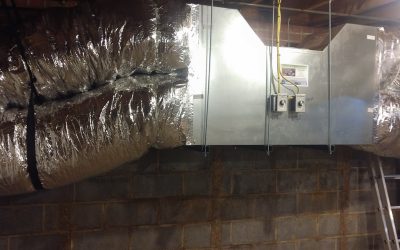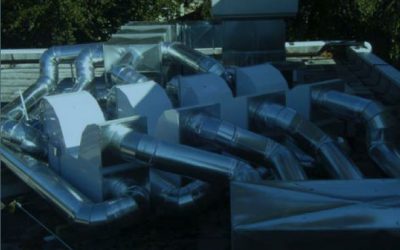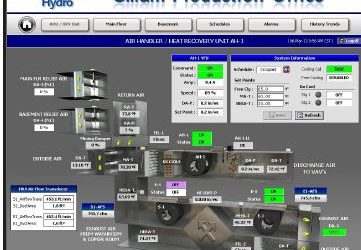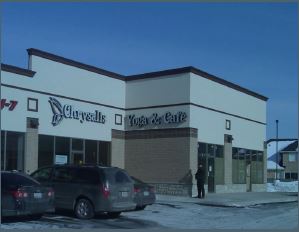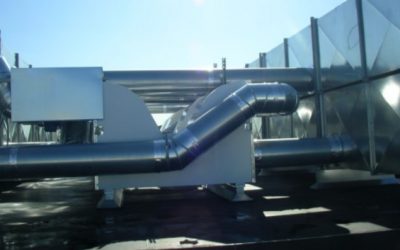Case Studies
Case Study: Grateful Heads Beauty Salon, Monroe, North Carolina
Challenge: When April and Sam Kuhn set out to open Grateful Heads, a beauty salon, they needed to renovate the property they bought to local codes. Ventilation was a key area to consider given typical salon activities and chemicals that can lead to poor indoor air quality (IAQ) issues. Add a pandemic and the efficient displacement of indoor air with outdoor air became extra vital. Contractor solutions for the building were presented but knocked down by the Kuhn’s local permit office every time. So, Sam decided to research ventilation on his own. After finding Building Performance Equipment, Inc. (BPE), he explained the needs of the space to CEO and
ventilation designer, Klas Haglid, P.E., R.A.
Machine Shop, Massachusetts
Challenge: When fresh air exchange is poor, machine shops are known for exposing occupants to chemicals, oils, solvents, hotter ambient air temperatures, and sometimes humidity. This typical screw machine shop turns long bars into custom parts. The oil-based coolants necessary for running the machines exposed employees’ senses to oily, heavy, stagnant air—to the point where the shop sometimes took on a haze. The smell and discomfort grew worse throughout the day. This shop needed a cost-effective solution for improving air quality and thermal comfort pronto.
Case Study: Carmelite Monks, Meeteetse, WY
When a group of Carmelite monks in Wyoming needed more living space, they reduced costs on building a stone European Gothic monastery by carving and installing the limestone and sandstone themselves. The learning curve and time commitment for learning everything from excavation to stonemasonry, CAM (Computer Aided Manufacturing) programming, 3D modeling, and CNC (Computer Numerical Control) operation makes their continuing commitment to finish the project impressive indeed.
Also impressive? The amount of humidity CNC systems create in a room while cutting stone. Powered by a high-pressure water pump, the machines cut through the stone using high-speed water jets. Failing to control excess moisture in the air, especially in summer, creates condensation when the dewpoint gets high enough. Before long, you have machinery prone to corrosion, oxidation, and electrical shorts as well as the cost of replacing parts.
Comfort was another issue. The ventilation solution they sought would also need to warm Wyoming’s winter air—sometimes as frigid as -20 degrees—as it enters the stone carving facility.
Case Study: Alpacka Raft LLC
Challenge: A small company in Colorado that designs and hand-builds rafts with the best materials and techniques available (while operating completely off the power grid) needed a safer work environment. In a small 12 x 20 space, toxic acetone-based glue is regularly used to seal patch edges and for repairing gouged floors and pinholes. Without proper ventilation, the fumes from most glues can be quite hazardous to human health and flammable.
Case Study: Avidan Management
Challenge: Avidan Management’s 656,000-sq.ft. property had been labeled a ‘gas guzzler,’ making at least 200,000 sq.ft. of the structure challenging to rent. The facility included 40,000 sq.ft. of one-story office space, a 181,000 sq.ft. refrigerated warehouse, and 433,000 sq.ft. of mixed-use dry-warehouse space.
Case Study: Louvre Inspired Skylight
Challenge: At Haglid EngineeringTM, we’re passionate about coming up with sound, creative solutions for a vast array of engineering projects. After all, variety is the spice of life and we do enjoy challenges! Although … we never thought we would be asked to bring The Louvre to Saddle River, New Jersey—part of it, anyway.
Case Study: YMCA
Challenge: Chlorine and bromine smells from the pool and spa created poor indoor air quality (IAQ). Members complained that it was difficult to breathe in the main pool area.
Case Study: Saskatchewan Conservation House
Challenge: When it was built in 1977, the Saskatchewan Conservation House was one of the first completely energy efficient homes in North America. Our goal was to increase the energy and cost effectiveness of this passive house, which is nearly air tight, by improving the ventilation.
Case Study: Plymouth Cultural Center
Challenge: Cultural centers can be an enormous challenge in HVAC design. The number of occupants fluctuates day by day, hour by hour, so the building must provide fresh air over a large range of flows. If not, indoor air quality (IAQ) can suffer and energy costs can run a fortune.
Case Study: Our Yoga Place
Challenge: When Tom and Nancy Palmer decided to take on the challenge of opening a healthier, cleaner hot yoga environment, they didn’t know a pandemic was around the corner. In the best of times, Hot Yoga practice is held in studios heated at 105°F (40.5C) with at least 40% relative humidity to increase yoga’s effects on muscles and various systems of the body. In addition to the resulting sweat produced under such conditions, people expel higher levels of carbon dioxide (CO2) thanks to elevated heart rates.
Case Study: On the Move Convenience
Challenge: As part of an overall energy efficiency improvement project, the customer wanted to significantly reduce energy consumption utilized by the existing HVAC [Heating, Ventilating, and Air Conditioning] system.
Case Study: Newark Liberty International Airport
Challenge: The challenge was to bring fresh air to the back office areas of Newark Airport, which were isolated from outdoor air intakes by new construction and steel-reinforced concrete structural members. Using conventional ventilation techniques with partial energy recovery, hot/cold water coils, and ductwork to resolve this issue would have cost more than $100,000. Haglid Engineering fixed this problem for less than half the price.
Case Study: Jim Saxon Community Center
Challenge: Located in the heart of the United Communities development on McGuire Air Force Base, the Jim Saxton Community Center serves to commemorate 15 years of service given by New Jersey’s former 3rd District Congressman. Equipped with a computer lab (which contains a live video chat system for communications during deployment), exercise room, day care, dining room, conference room, kitchen, and backyard playground, this center serves as the backbone to a community of United States officers, airmen, and their families.
Case Study: Marty’s Reliable Cycle
Challenge: The challenge for Haglid Engineering was to renovate an existing retail bicycle shop, which was originally built as a home in the late 1800s, to achieve certification under LEED® for Commercial Interiors.
Case Study: Interlakes Animal Hospital
Challenge: The indoor air quality (IAQ) issue in this veterinary setting was quite obvious; strong odors from the animals posed a serious comfort problem. Fresh air needed to be brought into various parts of the building. It was requested that 15 air changes per hour be applied to the distribution of air.
Case Study: Manitoba Hydroelectric
Challenge: Manitoba Hydroelectric, Manitoba’s lead energy utility, purchased a BPE ERV for the purposes of instrumenting and evaluating the need for fresh outdoor air in below freezing conditions in an area of Northern Canada.
Case Study: Hunterdon Regional High School
Challenge: The goals of this project were to conduct an energy audit on Hunterdon Central Regional High School’s energy consumption, establish baselines for energy efficiency, and identify opportunities to reduce energy usage and its overall cost. The 213,718-square-foot facility, located in Central New Jersey, was constructed in 1955 with a few additions made throughout the years.
Case Study: Hopewell Valley Regional School District
Challenge: Hopewell Valley Regional School District sought to boost energy-efficiency throughout six school buildings and provide students and staff with improved indoor air quality (IAQ). Haglid Engineering & Associates (HEA) began the project with an audit of each school’s energy consumption, using the EPA’s ENERGY STAR® PortfolioManager® Tool and Energy Performance Rating System.
Case Study: Glatt Air Techniques
Challenge: A member of the world-wide Glatt group, which specializes in integrated-process technology, the company aimed to greatly reduce energy usage in its heat recovery functions through an energy-efficient means.
Case Study: Circle Management Athletic Facility
Challenge: This newly built facility needed fresh outdoor air to meet code requirements and had indoor air quality (IAQ) issues caused by the athletes’ vigorous training. Steve Opremcak, president of Circle Management, LLC, was seeking high-efficiency ventilation equipment that would provide adequate energy savings while improving the overall IAQ of the facility.
Case Study: Chrysalis Yoga Studio & Cafe
Challenge: Chrysalis Yoga & Café is not an ordinary yoga studio. The program line-up includes ‘hot yoga’, which is specifically designed to loosen muscles and allow for ease of stretching. Such classes are conducted within highly humid conditions at temperatures more than 105°F.
Case Study: Chanel, Inc.
Client: Chanel, Inc., International Manufacturer of Fine Perfumes in Piscataway, NJ. Challenge: This large international perfume manufacturer had issues with indoor air quality (IAQ), temperature control, and high energy bills prone to double-digit rate...
Case Study: Braen
Challenge: A 2,000-square-foot office suite with central heating and air-conditioning had serious Indoor Air Quality (IAQ) issues due to a manufacturing and welding facility situated directly beneath it. High levels of carbon monoxide (above 100 ppm) and combustion products infiltrated the office, which was evacuated.
Case Study: Bourbon BBQ
Challenge: After a major reconstruction was completed in 2011, Mike Feygin, owner of Bourbon BBQ, decided it was time to make his mark on the local community beyond his delicious barbecue – he wanted to establish the first green certified restaurant in his county.

